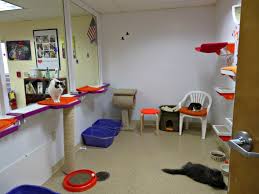Helping Semi-Feral Cats Adjust to Life Indoors

While a good deal of time and patience is involved in helping semi-feral cats adjust to domesticity, nothing succeeds more than time and patience, and nothing is a more gratifying experience.
Why?
Because semi-feral cats who have acclimated well to their new lives are some of the most loving, affectionate and appreciative kitties around.
Interested?
If so, consider the following five steps to help make your particular “wild child’s” adjustment to indoor living as smooth and swift as paws-ible.
1. Prepare a “dedicated” cat room: When you bring your new cat home, ensure her room has such amenities as scratching posts, some toys, food, water and a litter box. Not only should her food bowl and litter box be on opposite sides of the room, it should be quiet and, for the time being, out of bounds for other humans. It should also have some small, safe hiding places, like a cat house or a blanket draped over a chair, but nothing (a bed or sofa) that allows her to hide away from you completely, thereby removing herself from her new environment. Spend time in this room every day to get her accustomed to your presence. Read out loud to her, speak to someone on the phone or simply talk about anything and everything, allowing her to learn the sound of your voice and grow increasingly comfortable with it.
 2. Win her over with food: Food is key to gaining your new cat’s trust and earning her eventual affection. When you begin, it’s vital to adhere to a regular feeding schedule so that she learns you’re consistently and without fail the sole source of her delicious food supply. Once she’s relaxed enough to eat, start sitting in the room without interfering with either her or the food. This will assure her that she’s safe with you. Special foods such as “chicken in gravy” baby food is also an excellent way to “seduce” her into attempting new things as she acclimatizes herself to her new, domesticated life.
2. Win her over with food: Food is key to gaining your new cat’s trust and earning her eventual affection. When you begin, it’s vital to adhere to a regular feeding schedule so that she learns you’re consistently and without fail the sole source of her delicious food supply. Once she’s relaxed enough to eat, start sitting in the room without interfering with either her or the food. This will assure her that she’s safe with you. Special foods such as “chicken in gravy” baby food is also an excellent way to “seduce” her into attempting new things as she acclimatizes herself to her new, domesticated life.
3. Avoid direct eye contact: If you find your cat staring at you, do NOT engage. To feral cats, eye contact is considered aggressive. But should you inadvertently find yourself in a “staring contest”, the best thing to do is calmly blink, keeping your eyes closed for a few seconds, and turn your head away. This shows your cat that you hadn’t meant to threaten her, and are taking a submissive role, which, in turn, reinforces her feeling of safety and security.
 4. Don’t force physical contact: Your cat will come to you once she feels truly safe, something that can be encouraged and enhanced by using that “high value” baby food. Put some on your finger and have her lick it off. This both initiates contact between the two of you and allows her to form a positive association with you. Repeat this over and over until all hesitation on her part ceases. The next step is to try petting her. Start by extending a closed fist while looking away. Allow her to approach you and initiate whatever form of contact feels most comfortable to her.
4. Don’t force physical contact: Your cat will come to you once she feels truly safe, something that can be encouraged and enhanced by using that “high value” baby food. Put some on your finger and have her lick it off. This both initiates contact between the two of you and allows her to form a positive association with you. Repeat this over and over until all hesitation on her part ceases. The next step is to try petting her. Start by extending a closed fist while looking away. Allow her to approach you and initiate whatever form of contact feels most comfortable to her.
5. Be patient: According to an old axiom, “Patience, persistence and perspiration make an unbeatable combination for success.” And so it is when welcoming an outdoor cat into your home and heart. All felines are famously guarded; semi-ferals even more so. And although your kitty’s adaptation to indoor life may take longer than you may want, once you’ve succeeded – as a team — yours will be a love unlike any other.


